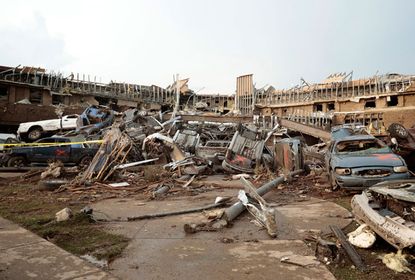Oklahoma tornado: how did it form and why was it so deadly?
Twister was a category four storm that struck the suburb of Moore with just five minutes' warning

THE DEVASTATING tornado that has killed at least 24 people and obliterated the Oklahoma suburb of Moore is one of the worst to strike in the US in decades. The twister was said to have been more than a mile wide – some reports claimed it was 2.5 miles across - and was in contact with the earth for around 40 minutes. Almost everything in its path was destroyed and the twisted metal, wood and other debris it picked up made the destruction worse. What causes a tornado? Twisters, as they are also known, form below thunderstorms when huge columns of air rising upwards through the storm suck in winds at ground level to create a vortex. "The twisting effect is triggered shortly before a thunderstorm develops, as the wind changes direction and becomes faster at greater heights," explains the Daily Telegraph. "This causes wind in the lower atmosphere to rotate in a horizontal swirling pattern, but the rotating current is then pushed upright by rising air currents within the thunderstorm." How powerful are they? The power of a tornado is measured on the Fujita scale. The one that devastated Moore is believed to have been a category four storm, one below the maximum, with winds of up to 200mph. However, measuring them is an inexact science because of the difficulty of obtaining readings. The impact of a tornado is also affected by the width of the vortex and the amount of time they are in contact with the ground. Why did this one cause so much damage? It struck a populated residential area. "The accumulated debris at its heart, including cars, simply adds to the devastating force with which it smashes through everything in its path," says The Independent. Also, when a tornado is as wide as the one that struck yesterday, other vortices appear within the main column and they can generate winds of up to 300mph, the BBC notes. What kind of warning was there? Meteorologists can monitor and track the weather systems that cause tornadoes but not the tornadoes themselves. According to the BBC, it took just half an hour for the storm over Moore to form and create the giant twister. Residents were given a warning 15 minutes before the twister touched down, but the alert was only upgraded to an emergency five minutes before the tornado struck. Why are there so many tornadoes in Oklahoma? The city sits in what is known as 'tornado alley' which runs through the states of Kansas, Oklahoma and Texas. It is here that warm, wet air blowing in from the Gulf of Mexico runs into cold, dry air from the Rocky Mountains, creating perfect conditions for the massive thunderstorms that cause tornadoes. May and June are the busiest months for tornadoes. Where does this one rank? The Moore tornado appears to be the worst to strike in the US since 158 people died two years ago, almost to the day, in Joplin, Missouri. Prior to that you have to go back to 1953 to find a more lethal twister. But it is not the first time Moore has been hit. In 1999, the same area was struck by a tornado that killed 36 people. The deadliest tornado on record struck in Bangladesh in 1989 and killed 1,300 people. Is climate change to blame? Although more tornadoes are being reported, the BBC says this is because it is much easier to report seeing a tornado, and that there are fewer places that are truly unpopulated. However, Suzanne Gray of Reading University told The Guardian: "Climate change means warmer temperatures and more moisture and that is providing more energy for the types of storms that produce tornadoes."
Subscribe to The Week
Escape your echo chamber. Get the facts behind the news, plus analysis from multiple perspectives.

Sign up for The Week's Free Newsletters
From our morning news briefing to a weekly Good News Newsletter, get the best of The Week delivered directly to your inbox.
From our morning news briefing to a weekly Good News Newsletter, get the best of The Week delivered directly to your inbox.
Create an account with the same email registered to your subscription to unlock access.
Sign up for Today's Best Articles in your inbox
A free daily email with the biggest news stories of the day – and the best features from TheWeek.com
-
 'A speaker courageous enough to stand up to the extremists in his own party'
'A speaker courageous enough to stand up to the extremists in his own party'Instant Opinion Opinion, comment and editorials of the day
By Harold Maass, The Week US Published
-
 How could the Supreme Court's Fischer v. US case impact the other Jan 6. trials including Trump's?
How could the Supreme Court's Fischer v. US case impact the other Jan 6. trials including Trump's?Today's Big Question A former Pennsylvania cop might hold the key to a major upheaval in how the courts treat the Capitol riot — and its alleged instigator
By Rafi Schwartz, The Week US Published
-
 Today's political cartoons - April 18, 2024
Today's political cartoons - April 18, 2024Cartoons Thursday's cartoons - impeachment Peanuts, record-breaking temperatures, and more
By The Week US Published
-
 Arid Gulf states hit with year's worth of rain
Arid Gulf states hit with year's worth of rainSpeed Read The historic flooding in Dubai is tied to climate change
By Peter Weber, The Week US Published
-
 The growing thirst for camel milk
The growing thirst for camel milkUnder the radar Climate change and health-conscious consumers are pushing demand for nutrient-rich product – and the growth of industrialised farming
By Harriet Marsden, The Week UK Published
-
 Why curbing methane emissions is tricky in fight against climate change
Why curbing methane emissions is tricky in fight against climate changeThe Explainer Tackling the second most significant contributor to global warming could have an immediate impact
By Richard Windsor, The Week UK Published
-
 How the EU undermines its climate goals with animal farming subsidies
How the EU undermines its climate goals with animal farming subsidiesUnder the radar Bloc's agricultural policy incentivises carbon-intensive animal farming over growing crops, despite aims to be carbon-neutral
By Harriet Marsden, The Week UK Published
-
 Why are people and elephants fighting in Sri Lanka?
Why are people and elephants fighting in Sri Lanka?Under The Radar Farmers encroaching into elephant habitats has led to deaths on both sides
By Chas Newkey-Burden, The Week UK Published
-
 How climate change is contributing to global unrest
How climate change is contributing to global unrestIn Depth Some experts argue that global warming can be tied to rising levels of violence around the world
By Justin Klawans, The Week US Published
-
 Why last-chance tourism is the latest controversial travel trend
Why last-chance tourism is the latest controversial travel trendThe Explainer Race to visit places threatened by climate change 'before it's too late'
By Austin Chen, The Week UK Published
-
 The 5 biggest corporate greenwashing fines
The 5 biggest corporate greenwashing finesThe Explainer Pretending to be green can be expensive
By Devika Rao, The Week US Published